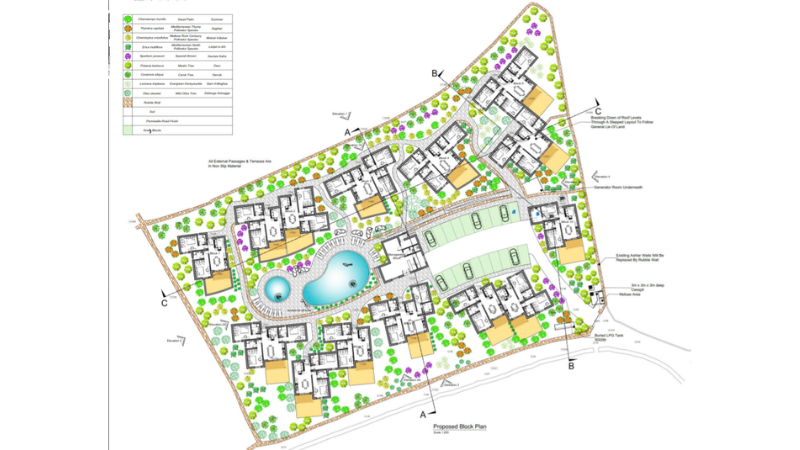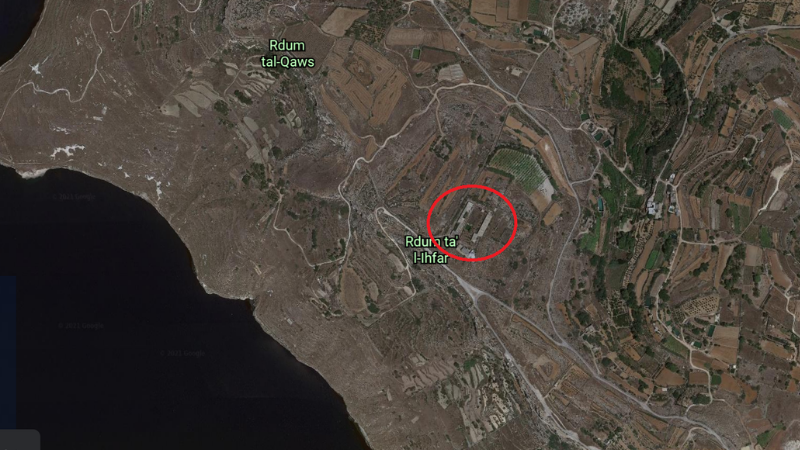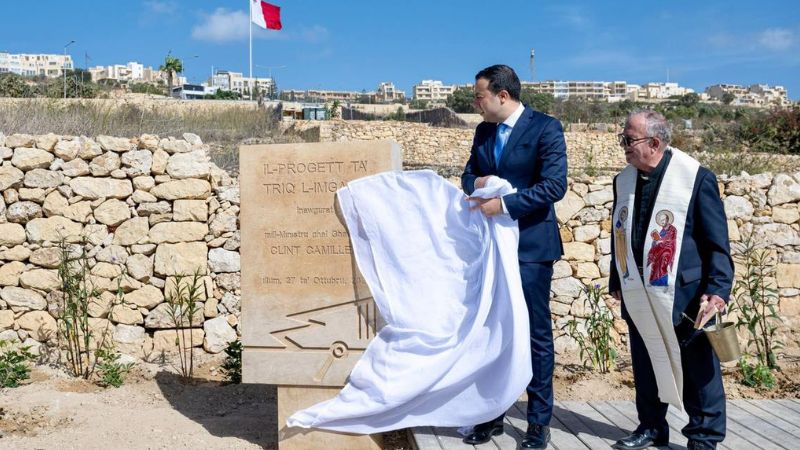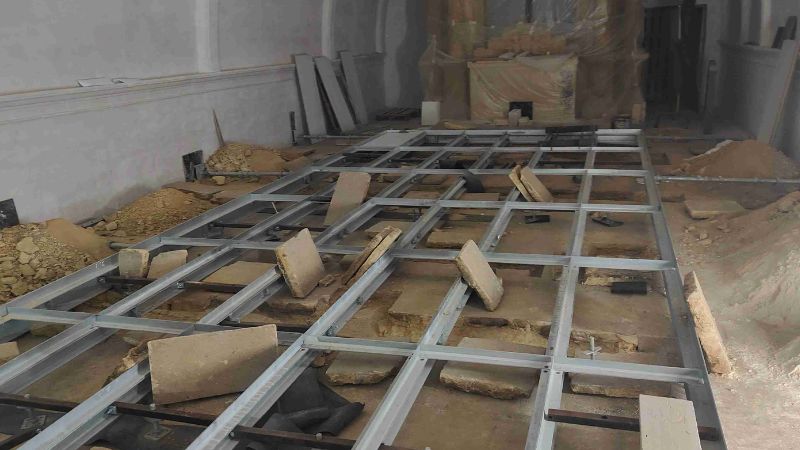The Planning Authority withheld crucial documents related to a controversial development application to turn an abandoned explosives factory in the outskirts of Dingli into a ‘tourist development’ – thus facilitating the proposed granting of this permit, The Shift has learned. These documents indicate that the project is actually planned to include a banned residential element.
The documents, which show that the ‘tourist development’ term being used by the developers is just a euphemism for a cluster of disallowed residential bungalows, were uploaded for public view only after the closure of the consultation and objections period, and just in time for next week’s expected approval of the development application.
Investigations by The Shift into the controversial Pulvich Explosives factory, located just across from the majestic Dingli cliffs, shows that while the documents had already been in the possession of the PA for over a year, they were only uploaded to the public database after the objections period had closed.
This means that objectors, some 500, were precluded from analysing these documents and presenting further representations as to why the ODZ abandoned factory should not be developed in the middle of a Natura 2000 site.

The most recent plan for the development of the Pulvich Explosives factory site, recommended for Planning Authority approval next week.
The documents, seen by The Shift, include two crucial Project Description Statements prepared by the architects of the applicant, JG Periti, which clearly reveal that the 14 units being proposed are to be used as “holiday homes” and “retreat residences” and not as holiday complex rooms as the developers and the PA claim.
According to planning rules, it is strictly forbidden to build residences in this area.
The hidden documents also include the original 1987 building permit issued to the proprietors by then Public Works Minister Lorry Sant, clearly stating the development was only to be used as an explosives factory and “not as furnished holiday flats for tourists”.
Despite this clear condition and numerous planning policies precluding the redevelopment of this factory into anything else, the PA is now recommending the issue of a permit and has scheduled its green light for next week.
How an abandoned factory will be turned into a gold mine
Set far away from any other homes on the outskirts of Dingli, just metres away from the ridges of the Dingli cliffs, the Pugliesevic family from Dingli were granted a permit, just before the 1987 election, to turn their disused land into an explosives factory.
The permit was issued in this particular area to ensure that, due to the dangerous nature of explosives, the factory would be located in a safe environment, far away from any residences or social activity, in case of an accident.
The permit made it clear that the land – bought on very cheap terms due to its remoteness and undevelopable status – was only to be used as an explosives factory and nothing else.

The original, 1987 permit for the Pulvich Explosives factory, clearly excluding the possibility of any future use of the site for tourism purposes.
While the factory – spread over an area as large as a football ground – was successful for a few years, it was closed a decade later as explosives, used mainly in the construction industry, were replaced with modern technology.
Since then, the Pugliesevic family, either alone or jointly with well-connected businessmen, has applied persistently over the years to turn their unused building into other more lucrative businesses such as garages, storage facilities, residences and even a SPA hotel.
All these applications have been turned down over the past two decades, including at appeals stage, with both the PA and ERA insisting that the area is a Natura 2000 site, of ecological importance, and a special area of conservation which does not allow any form of development.
Sudden ‘interest’ from Infrastructure Malta
In 2017, soon after Minister Ian Borg – also a Dingi resident and former Mayor of the locality – took over the political direction of the Planning Authority, the Pugliesevics revived their interest in the site, presenting an application for a Spa and resort to replace their abandoned factory.
In the meantime, Infrastructure Malta – also under the political wing of Minister Borg – began paying close attention to the rural area, redoing the roads leading to the factory and inserting a new water pipeline along the road, in which there are no other residences or developments bar the abandoned factory. The heavy-duty water main, which cost taxpayers €350,000 to install, stops just metres away from the Pulvich Explosives factory.
Both these projects, paid for out of public funds, are now the subject of magisterial inquiries on possible abuse.
In 2020, having finally recognised that planning permission for a hotel in the area would be refused, the applicants submitted a fresh application to develop the site into a complex of residential bungalows. This application was later also withdrawn and reworked into a new application for ‘holiday homes’ as part of a ‘touristic development’.
The Malta Tourism Authority has now said it had ‘no objection’ to such a development, despite the hundreds of objections, while the ERA made a spectacular U-turn and withdrew its objections.
The PA has also done an about-turn, and is attempting to justify this change of heart by claiming that the project would be acceptable, as long as it’s for a luxury tourism development.
Its case officer, Jonathan Orlando, is now recommending the permit be granted.
To mitigate the PA’s concerns, and in contradiction of the original 1987 permit, the case officer is also proposing a public deed in which the developers are bound to use the site for tourism purposes only, and as one functional unit. The deed will also note that none of the units “can be sold or transferred separately”.
The PA will be discussing the permit next week.
The current application is being fronted by Maria Sant – one of the shareholders of JB Stores and operators of the Hotel Santana in St Paul’s Bay, even though she does noy own the land. The manager of the hotel owned by the JB Stores family is George Micallef – a prominent member of the MHRA who also sits on the board of the Malta Tourism Authority.
Featured photo: Location of the Pulvich Explosives factory at Dingli Cliffs, in one of the remotest areas of Malta and a Natura 2000 site, where the supposed ‘tourist development’ would be situated, if the PA grants it a permit.













It is all so blatant!
Shame , shame shame bhal restaurant hdejn il historical site? liema ministru involved? tajd listess wiehed?
More than 500 people who submitted representations about this application – which should not have made it past the screening phase – have been deceived by the Planning Authority led by Martin Saliba, Ian Borg’s appointee.
Mr. Saliba’s resignation will not be enough to remedy this.
This application merits a proper, full, criminal investigation, not the Planning Board’s approval.
Looks like intentional fraud by the gatekeeper if facts are as stated in this article
According to a recent Planning Tribunal decision, the Planning Board (or the Planning Commission) is assumed to know the Local Plans and policies well. And rightly so.
Therefore the Planning Board will not need my input to know that the Pulvich Explosives application PA/05257/20 for a “tourist drvelopment” consisting of 14 residences at the highly protected Dingli Cliffs, not very far from the Dingli Interpretation Centre, cannot be approved in terms of the Local Plan and policies applicable to the area.
Starting with local plans, which define the permissible land uses for any given site, the application fails under Policies NWTO 1 and NWTO 2 of the NorthWest Local Plan.
NWTO 1 states that the Planning Authority may only consider favourably the location of tourism accommodation in a rural area if there is a building worthy of preservation, in which case the PA may permit a new tourism accommodation or a conversion of the building. The reason for such policy should be obvious to anyone familiar with Planning issues.
NWTO 2 allows the rehabilitation of an existing rural tourism accommodation.
Beyond that, no new tourism accommodation, or conversion therefore, is permissible. And in fact, I am not aware of any new or converted tourism accommodation that was permitted in the past 20 years in the North West of Malta.
Since the Local Plan defines land use and is above the RPDG 2014 in legal hierarchy, a rural tourist accommodation is not possible under any RPDG 2014 policies, no matter how fancily those policies may have been designed.
Fact is, the application is being recommended for permission in terms of the RPDG 2014. This is in breach of the above NWLP policies.
Also, the application is being proposed for permission in terms of the RPDG 2014 Policy 6.2C, which, among other requirements, includes adequate roads to the site.
But Policy 6.2C precludes the redevelopment of existing buildings into dwellings, which is what the application proposes to develop despite the attempt by the PA to conceal this fact. Therefore, the application fails also under Policy 6.2C independently of the NWLP policies.
I think the above is a concise explanation for interested parties. I admit, on the subject of Local Plans, the best authority is Ian Borg, the Infrastructure Minister, who repeatedly cites the 2006 Local Plans to justify the road and yacht marina projects undertaken by his ministry.
So sick of this. Everyone on the island knows that MEPA cannot be trusted, yet it goes on and on. Are we so stupid or what. Unless the people demand justice each government will keep on using this money making institution to fill their pockets and ruin our islands with complete impunity.
Investigate Ian Borg as soon as possible!
Not only Ian Borg but all his person of trust especially those working at Transport Malta Chairman/CEO & Deputy CEO included.
Ara naqra fejn sejrin jibnu! Tal misthijaaa!
Corruption galore!
for two decades the applications were declined until Ian Borg came to the rescue!!!
was it votes? Money? What turns you on Ian? Destruction of the environment or all of those put together????